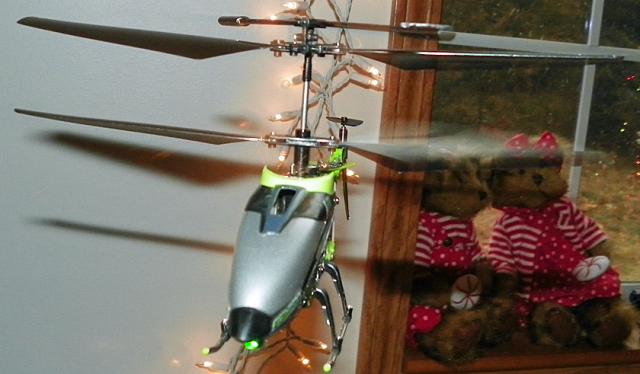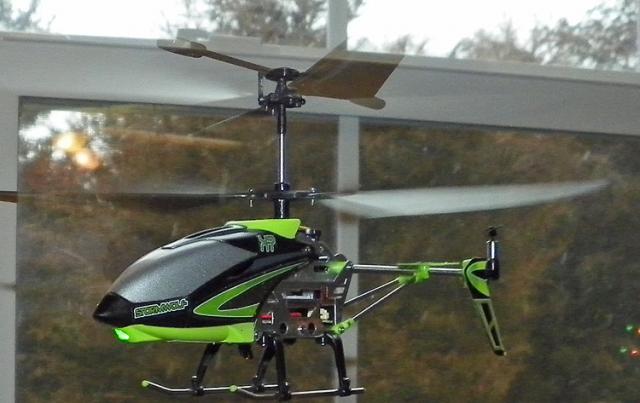I will try to describe with words, the 2011 post-holiday sounds in the Close house: Whine. Thump. Whine, Rattle. Whine. Whine, whine rattle. Whine. Crunch, scrape crash. "Ahhhh! Oh, No!"
It's silly, I know, for a 46-year-old guy to ask for a toy helicopter for Christmas.
But she asked what I wanted. That was it.
My tiny, indoor-flying-only BladeRunner Storm Wolf is the coolest toy I have had since my Evel Knievel Motorcycle/RV kit that I had nearly 40 years ago (I actually got the bike and rider to jump over the RV with the ramp, just like in the commercial -- once).
Despite my childhood motorcycle ramp-jumping success, usually I encounter nothing but spectacular failure with my attempts at making toys function anything like their full-size inspirations. Models. Flying airplanes. Erector sets. I never could get them to look or function the way the commercials show. I'd say I have had bad luck, but Mrs. Santa would say that a more honest explanation would be a lack of skill, common sense and/or a lack of paying attention to directions.
The new helicopter, which Mrs. Santa bought at the Radio Shack/LaGrange Pharmacy, only weighs three, maybe four ounces. It's powered by a tiny battery in the helicopter that needs recharged from the batteries in the controller. You can fly it for about five minutes; then you have to recharge the helicopter batteries. Then after four or five flights, you have to recharge the batteries in the controller. I can, therefore, fly it for only about 30 minutes a day.
It's taken me a week to manage the two-button controller. One button spins the double main rotors; the other controls the tail rotor, which turns the bird. It's a credit to the Interactive Toy Company that after a week of bouncing off the walls, ceilings and floors of my house -- and once even having two of its four rotor blades stuck in the tiny crack between the ceiling and the trim at the top of the wall -- that the machine still flies.
In between crashes, I have managed to learn to fly the helicopter from one end of the house to the other. I have even managed to land it on small targets such as the top of a Christmas popcorn tin or the granddaughter's high chair tray.
What most intrigues me about the helicopter, however, is how that my toy helped me appreciate just how difficult it is to fly any kind of helicopter, and how dangerous it is for anyone to ride in one.
Just look at any helicopter: It's the only flying machine that does not either have wings or hot air holding it up.
Helicopters work great when the rotor spins fast enough to provide enough air pressure to keep it above ground. But when the rotor stops, boom. Crash.
After seeing my tiny chopper fall countless times to the floor, or bang into the wall, I realized that the law of physics pretty much doom a helicopter that has any kind of mechanical problem. In fact, the main rotor is attached to the engine shaft by something that is called a "Jesus nut." That part got its name from the idea that if you have a problem with that particular piece of equipment, you're either going to need God's help, or you're about to meet Him.
That nickname is a humorous description of a horrendous reality: Ten percent of American Vietnam War casualties died in helicopters that either crashed or were shot down. In the Iraq war, of the 160 serious aircraft incidents (crashes or downings), 130 of them involved helicopters. Some Iowans lost their lives in helicopter incidents in Iraq or Afghanistan.
The frequent crashing of my toy helicopter has given me a new appreciation for anyone who flies a real one: Air ambulance crews. Forest firefighters. Military personnel.
It's tough enough keeping a 20,000-pound machine in the air using fan blades that weigh maybe a couple hundred pounds. Imagine how much tougher it must be when you are trying to fly this machine in the dark, in a sandstorm, while people are shooting at you.
The toy helicopter has a feature that very few real helicopters have: Double rotors that spin in opposite directions. This allows the machine to fly with much more stability than otherwise. But most helicopters, in order to allow their users to do the jobs for which helicopters are required, can only use one rotor.
Toy technology is remarkable; I marvel at the people who invented a tiny toy that even I can fly. Our military technology is also remarkable. It's amazing what a trained guy can do with the equipment in Uncle Sam's toy box.
But like my toy, these big machines also are subject to the laws of physics. And when things go wrong, the noise is much louder, the experience more painful.
I think of those guys every time I see that tiny reminder of the challenges and dangers they face every time they fire up the engines of their flying machines.


Comments
Submit a CommentPlease refresh the page to leave Comment.
Still seeing this message? Press Ctrl + F5 to do a "Hard Refresh".
Mac: Call me; we can fly together some time! -Editor Dean